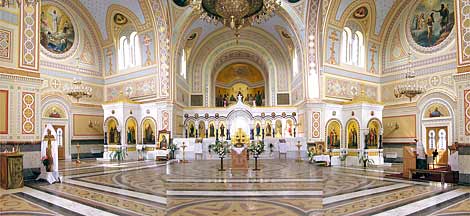Chersonesus Cathedral


The Saint Vladimir Cathedral (
History
According to legend and historic facts, the
The idea to immortalize the place of the Baptism of the Holy
Building

The author of the project of St. Vladimir Cathedral in Chersonese was academician David Grimm. According to his plan, the cathedral was built in Neo-Byzantine style. The construction took 15 years and was finished in 1874–1876, with the assistance of engineer M. Arnold. It was one of the biggest cathedrals in Russia (height – 36 m, total area – 1726 sq. m, dome diameter – 10,5 m) and could accommodate up to a thousand people.
The building consists of a lower (winter) and upper (summer) church.
The decoration of the church began on the eve of the 900th anniversary of the
As far back as 1859, the marble reliquary in the form of a Gospel[

Reconstruction
During World War II the cathedral was destroyed. Work on its restoration began in the late 1990s. The project of reconstruction was carried out by the Kiev Institute “UkrProjectRestoration” under the direction of architect E. Osadchiy. From 2002 Vladimir Cathedral was painted by artists from St. Petersburg, Kiev and the Crimea, who recreated the lost paintings of academician A. Korzuhin. The following monumental compositions can be seen on the walls of the cathedral: “The Holy Spirit” (authors – L. Steblovska, E. Revenko), “The Baptism of Christ” (author – A. Dmitrenko), “The Transfiguration of Christ” (authors – L. Dmitrenko, N. Dmitrenko), and “The Lord's Last Supper” (A. Pigarev, K. Popovskiy). The icons for the marble iconostasis of the Upper Church were painted by the young artists A. Dmitrenko and N. Dmitrenko.
The consecration of the high altar of Vladimir Cathedral in Chersonese took place on April 3, 2004, and a week later the Easter liturgy was celebrated.
